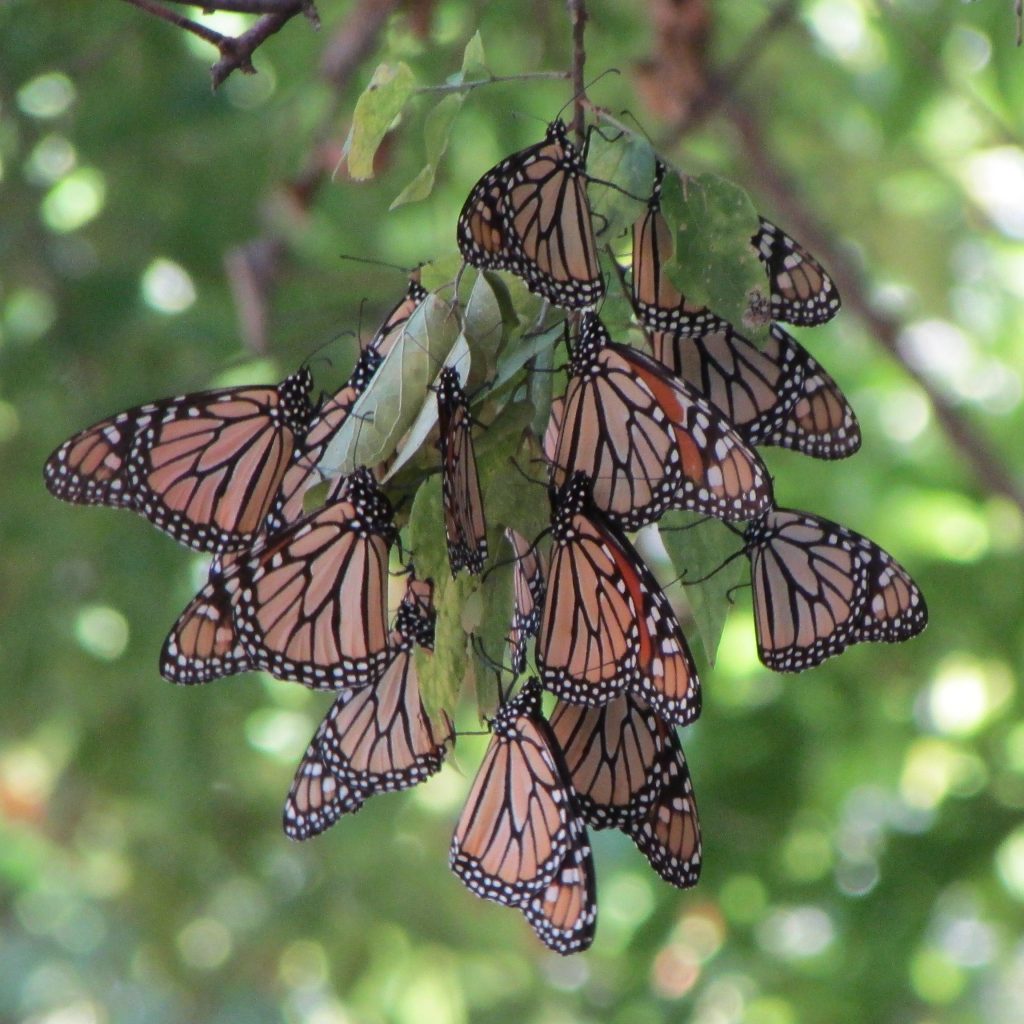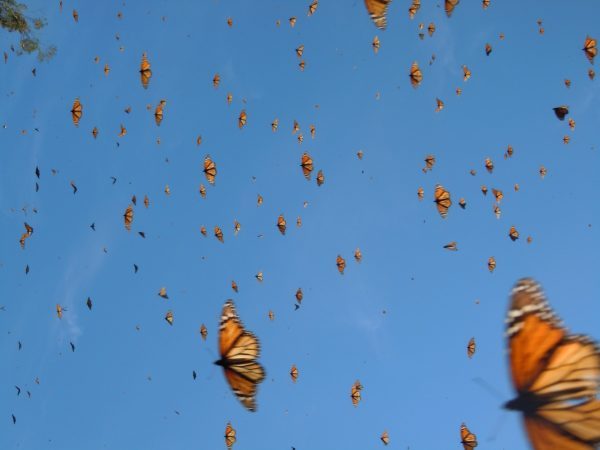When it comes to the 2019 monarch butterfly population, the numbers suggest catastrophe in California and a rebound in Mexico.
On the west coast, the news is dismal. The western population of monarch butterflies, which travel up and down the California coast, hit a historic low this year according to a study by the Xerces Society.

The California monarch population has dropped 86% since last year, according to the Xerces Society. Photo by Jenny Singleton
Xerces, a pollinator advocacy organization based in Portland, Oregon, has been monitoring the California monarchs for decades. In 1981, more than one million of the iconic orange and black insects were recorded overwintering in eucalyptus trees along the Pacific coast.
This year? The group’s most recent count over Thanksgiving weekend recorded less than 30,000 butterflies—an 86-percent decline since 2017 alone.
Emma Pelton, the Xerces biologist who oversaw the study, called the findings “potentially catastrophic” and a “wake-up call.”
“Extinction looks increasingly likely,” a January 6 story in the San Francisco Chronicle claimed. “The monarchs’ flight seems more perilous than ever,” said the New York Times in a January 9 piece headlined California’s Monarch Butterfly Population Hits Record Low.
Wildfires, deforestation, climate change, pesticide abuse, and poor land management have all conspired in recent years to quicken the pace of monarch butterfly decline in California and elsewhere. Even so, most monarch scientists don’t believe monarchs will become extinct.
“The migration won’t last forever. The monarchs will,” said migration expert Andy Davis, Assistant Research Scientist at the Odum School of Ecology at the The University of Georgia and editor of the journal, Animal Migration. “The monarchs will adapt just like they have in every other population around the world,” he said.
Davis recently shared news of several recent studies on monarchs on his educational MonarchScience blog, including one by Hannah Vander Zanden, an assistant professor at the University of Florida. Her research showed in a small sample that almost 40% of monarchs in Florida have migrated from the Midwest or elsewhere.
The Vander Zanden paper, “Alternate migration strategies of eastern monarch butterflies revealed by stable isotopes,” seems to upend what we thought we knew about the fall migration of eastern monarchs, wrote Davis. “We’ve always assumed that the winter destination of the eastern breeding population is the mountains of Central Mexico, but what if it isn’t? What if they don’t ALL travel to Mexico…what if over time, greater and greater numbers of monarchs are choosing to travel to these ‘alternate’ winter destinations, like South Florida? Wouldn’t that mean the Mexican overwintering colonies would slowly decline in size?”
The above video by Joel Moreno at JM’s Butterfly B&B shows the massive numbers at Cerro Pelón, part of the Monarch Butterfly Biosphere Preserve in the state of Mexico.
Perhaps, but not this year. The 2019 crop of monarch butterflies that roost in Mexico appears to be having its best year in a decade.
Karen Oberhauser, cofounder of Monarch Joint Venture and Director of the Arboretum at the University of Wisconsin, Madison, said this year’s eastern monarchs experienced a “perfect storm of conditions.” Chip Taylor of Monarch Watch agreed.
“We’ve had a set of dynamics in the east that were really, really good,” said Taylor.It’s still early in the season, and a freak freeze or catastrophic climate event could change everything, but monarch butterfly followers are hopeful of a huge rebound in the eastern migratory population this year. The official count won’t be released for several weeks, yet every indicator suggests the numbers of monarchs at the roosting sites in 2019 will be one of the biggest in a decade.

Scientists are cautiously optimistic about this year’s migratory eastern population. A freak storm like the one that occurred at Sierra Chincua could change everything. Photo by Dr. Isabel Ramíro
Taylor was so upbeat about the overwintering population, he encouraged readers of the much followed DPLEX list, an email community that closely tracks news of the migratory butterflies, to visit Mexico and see the rebound for themselves.
“In case you haven’t gotten the message, this is the year to visit the monarch colonies in Mexico,” Taylor wrote in late December, while sharing news of impressive butterfly numbers from visitors to the preserves. “The reports suggest that the overwintering population this year is the largest since 2008 and could even be larger than the 5.06 hectare population recorded that year. A population of this size may not occur again for another decade, and perhaps never, given the increasing temperatures in March and April that greet the monarchs returning from Mexico.”
Ellen Sharp, of JM’s Butterfly B&B, which sits at the entrance of the Cerro Pelón preserve near the small town of Macheros, Mexico, also chimed in about the big monarch numbers. “We’re having the most populous season in decades,” Sharp posted on Facebook.
What could explain the disparate numbers in monarch populations east and west?
“There’s pretty good evidence that they’re just not correlated,” said Oberhauser. “What goes on in the east is not connected to what goes on in the west because we have different weather patterns.”
Related posts:
- Weird, late migration finally reaches Mexico
- Banner year for monarch butterfly migration? Texas Hill Country ready
- Monarch Butterfly and Pollinator Festival 2018 to take place Oct. 19-21
- Five monarch butterflies tagged at Monarch Festival in San Antonio make it to Mexico
- Monarch Festival soars in San Antonio
- How to Tag a Monarch Butterfly in Six Easy Steps
- What does climate change mean for Monarch butterflies?
- New study: late season nectar plants more important than milkweed to Monarch migration
- Monarch butterflies head north as Mexican scientists try to move their forest
- Can’t get outside? Here’s how to track the Monarch migration from your desk
Like what you’re reading? Follow butterfly and native plant news at the Texas Butterfly Ranch. Sign up for email delivery in the righthand navigation bar of this page, like us on Facebook, or follow us on Twitter, @monikam.


Karen Oberhauser hit the sweet spot referring to the difference in the eastern and western monarch populations dynamics being the weather. She said in the last sentence of the above article.
“There’s pretty good evidence that they’re just not correlated,” said Oberhauser. “What goes on in the east is not connected to what goes on in the west because we have different weather patterns.”
Drought conditions have been extensive in California 10 out of the last 12 years. Native milkweed on the landscape goes dormant during drought. If last years rains continue on the western monarchs range over the next few years those milkweed will recover and naturally propagate and so will the monarch population. https://en.m.wikipedia.org/wiki/Droughts_in_California
The recovery of the eastern monarch population over the last 4 years is attributed to normal percipitation returning after catastrophic drought conditions from 2010-13 The population increased 800% over the 24 month period following the all time low during the 2013-14 season when normal percipitation returned. The native milkweed and nectar sources recovered. https://en.m.wikipedia.org/wiki/2012%E2%80%9313_North_American_drought
One of the most important things we can do is what Monika is doing by promoting citizens planting pollinator gardens in there yards where there’s a supplemental water source available. Pollinator gardens with a supplemental water source not only feed monarchs and pollinators during normal weather seasons but also keep a remnant of monarchs and pollinators going during catastrophic drought conditions which are sure to return on the eastern range also.
I went to see the western monarchs last February and one of the main groves was closed due to disease and the other groves looked very dry and withered. There was a decrease in population then also. We drove through the lands devastated by fires and they’re not that far away.
Monarchs should be way up this year in Mexico. 2018 was one of the wettest years ever east of the Rockies
https://weather.com/news/news/2018-12-15-record-wet-year-2018-washington-dc-baltimore
What of the catastrophe that the cell towers and the EMF radiation being blasted into the atmosphere are destroying the insects. Look at the plight of the bees. These creatures rely on navigation and the vibrations of the earth. The cell towers close to bee hives have been proven to destroy a working bee hive within days as the bees simply get lost and die. What evils of mankind are doing to the earth is catastrophic. Insects and birds are the first to vanish in existence when things go totally haywire. This is all avoidable. Technology of the cell phones and the EMF radiation were never tested to see what the effects on the earth, people and plants would be. We are now realizing that it is deadly to all forms of life. My heart breaks for the poor insects who can only do what nature intended them to do and that purpose has been removed in their navigation system as well as the weather altering scenarios that have been occurring. Watch these good documentaries: “Take Back Your Power” and “Mobilize” and “Wi-Fried” and “Generation Zapped”. Also see this website with valuable information regarding the EMF radiation relating to insects. https://ehtrust.org/published-research-adverse-effect-wireless-technology-electromagnetic-radiation-bees/
Wow, so glad to hear that the numbers are up in Mexico. Hope everyone has their milkweed ready for the big event, lol. Lots of egg laying in their future.
As for California, the drought and the wildfires have taken a toll on the trees. Perhaps the wildfires themselves were at an inopportune time for their migration. I think – I hope – the butterflies are overwintering in other areas in the state – or have avoided this state. Arizona butterflies, for example, can fly to either California or to Mexico. Our winter storms are providing much needed water; I believe they will adapt and rebound.
I will add that the reason I started bringing caterpillars inside is because my neighbor was having some real problems with the tachinid fly. I thought, challenge accepted! Prior to that, I simply grew milkweed outside and figured I’d let nature take its course.
As others also experienced, I noticed that if I brought caterpillars in too late, they were already infested with the maggot. If I brought in the eggs or very small caterpillars, they were fine. During my research, I found that the flies had been bred to destroy the tomato moth. Alas, they didn’t stick with moth larvae. I also learned that the butterfly larvae put out a different pheromone when they are in the 5th stage and they cannot hide from the fly. Interestingly, the flies would even manage to get inside the house.
Now with these numbers for California – which is where I live – I do wonder how widespread the problem is. It would be an interesting study.
Monarch numbers in Mexico highest in over ten years. https://l.facebook.com/l.php?u=https%3A%2F%2Fmonarchwatch.org%2Fblog%2Fuploads%2F2019%2F01%2Fmonarch-population-figure-monarchwatch-2019.png%3Ffbclid%3DIwAR19utu1SePj1m0XWqzxZX8FcLY8GMnRm_xgCLqrG0CZLLVEkWkRls_Bz20&h=AT2TvZ3Cz-B4bTg5NSy-7Sq6BLYqZZh3x9hjabRXwgDiruBZF7556b8FBPH7tRg44mOcDtvqffHhLgMupvnuj2C1aT9TnsnhkN6DS8c0m9xqcGpABcwkyaqv0o5ZOEwagvMQLrC4ekgHtGTNXxav5kV1Xzi6EHCP
I’m happy to hear that the Mexico overwintering monarch population has rebounded – at least so far – but winter isn’t over yet. The most important number hasn’t been tallied yet, and that’s the number of monarchs that will return north in spring.
On the western monarch population possibly rebounding if the drought conditions take an extended vacation: I’m not as hopeful. I’ve been surveying Eucalyptus groves in California, from Pismo Beach south to the Mexican border in San Diego County, taking part in both the Thanksgiving and New Year counts. The trees in every site I’ve visited are diseased, dying, dead or infested with beetles. The trees are in such bad shape that limbs are breaking off in the wind, and very few are blooming. The sites are in dire need of restoration and rehabilitation, but at the same time there is increasing pressure from multiple directions to remove eucalyptus trees from the ecosystem. The trees are not native to California, are classified as “moderately invasive,” and burn fiercely during the California wildfire season. It’s unlikely that any significant financial resources will be invested in saving these groves. Without healthy eucalyptus groves in which to overwinter, the prospects for the future western migration are slim.
Will the monarchs survive in California without the migration? Yes, for a time. Local, sedentary pockets of monarchs will continue to breed, especially in warmer micro-climates along the coast. People will continue to raise and release them, but without the migration, how will monarchs get to northern California, Oregon, Washington state, British Columbia, etc., in the spring? And without the annual infusion of migratory genetic diversity, even the monarchs in southern California will begin to fail.
I realize that I sound very pessimistic, and I hope my fears turn out to be unwarranted.
All you can do is a rain dance. Record rains on the eastern range increased the population. Take it to the bank rookie. 🤠🤠🤠🤠🤠🤠.
Conditions in California today aren’t any different than monarchs have experienced intermittently in just the last couple hundred years. We know remnant populations have survived before producing even more monarchs than we’re counted in the early eighties. In spite of what the Xerces society perpetuates that makes its living ion doomsday predictions. Normal rains will return for a couple years and those native milkweed taproots that are a couple inches below the surface will force their way back up through damp ground and put on stems and leaves like they have done for thousands of years in spite of what you hear. I do have to respect the directors of the Xerces Society, the same people that donate their hard earned money to Xerces are the same people who go out with the pick axes and shovels to plant the plants they also buy. Go figure 🤔 I want to let those people in on something take your money and plant a big pollinator garden,with lots of milkweed in your backyard and watch for and catch a monarch you see laying eggs. Put it in a 2′ x 2′ x 3′ popup (you can find on Amazon for under $30 ) you have put in a window with a big bouquet of rinsed leafy milkweed in a vaselike container full of water in the middle of the popup,and add rinsed milkweed as the caterpillars hatch and grow. In less than a month you will have around 100 crysalis ready to turn into beautiful healthy monarchs you can release to add to the beauty of your blooming backyard and spread all over your neighborhood.
Yes, I agree with you about the trees, Rob. I started noticing this about five years ago. I do hope the butterflies will go back to the native trees they utilized prior to the eucalyptus plantings prevalent in the 19th century. I sure do wish I could go back in time and see what the migration looked like back then!
[…] migration won’t last forever. The monarchs will,” said migration expert Andy Davis, Assistant Research Scientist at the Odum School of Ecology at the University of Georgia and editor […]
[…] In a year full of bad headlines involving insects (insects populations declining globally, National Butterfly Center, one of America’s richest butterfly habitats threatened by Trump’s wall, Western migratory monarch population drops by 87%), one ray of light stands out, giving us a shimmer of hope: The Mexican migratory monarch population is seeing it’s highest numbers in over a decade! […]
Ummm excuse me but can i get like information to the monarch butterflies please and thank you😊
[…] migration received’t final eternally. The monarchs will,” stated migration professional Andy Davis, Assistant Analysis Scientist on the Odum Faculty of Ecology on the College of Georgia and editor […]